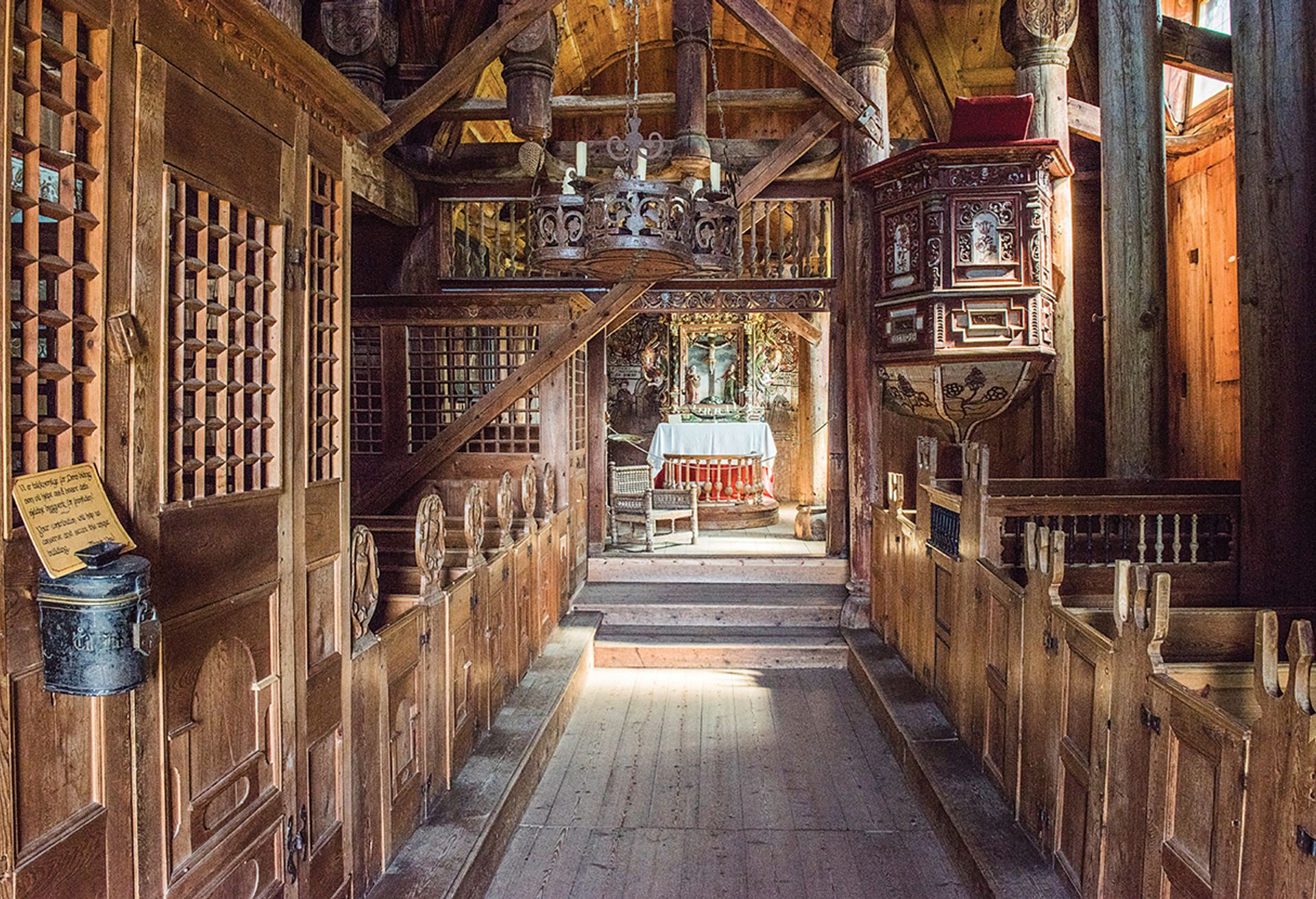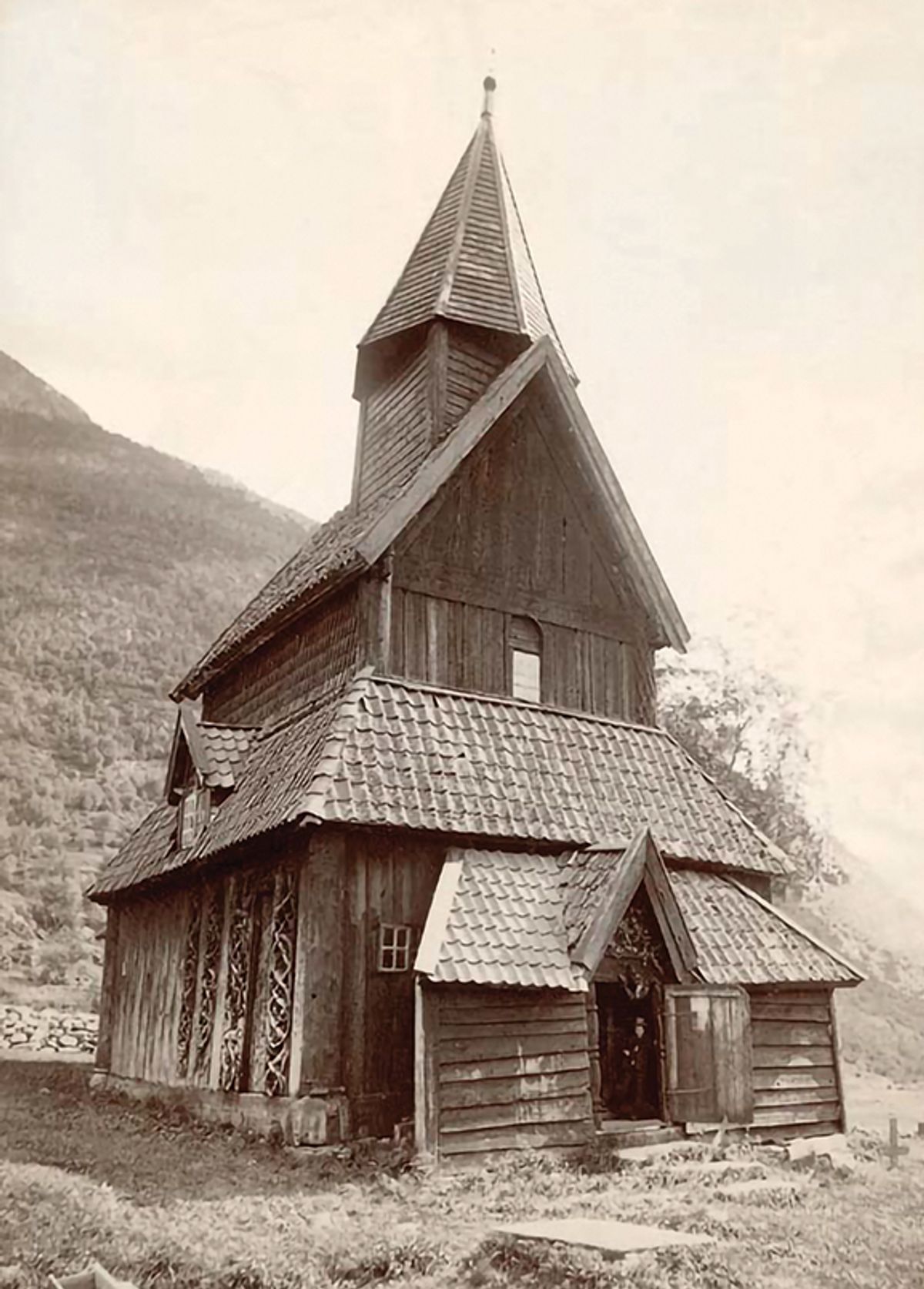The medieval wooden “stave” church at Urnes by the Sognefjord in western Norway is one of art history’s most mesmerising Sleeping Beauties. For all that it enjoys Unesco world heritage status, has given its name to an artistic style, and is without question both the most significant and hauntingly beautiful of the fewer than 30 surviving Norwegian stave churches in existence, it can only be a distinctly select, happy few non-Scandinavians who have ever actually made the pilgrimage to see it—until fairly recently the easiest way to reach it was by boat.
Thankfully, the copious illustrations of this new book are the next best thing, since they combine exemplary detailed photographs with evocative views of its situation: in one particularly memorable case against the wintry backdrop of the fjord and snowy hills beyond.

Interior from the west Siri Uldal
What makes Urnes so very, very special? In the end, and in spite of the undoubted architectural merits of the building itself and the fascinating carved nave capitals and other elements of its interior, it is the extraordinary fantasy and refinement of the carvings now to be found on the north exterior wall. Intriguingly, they originally adorned the west façade of a previous church on the site and were evidently lovingly preserved when it was replaced.
Almost inevitably, a detail from this decoration graces the cover of James Graham-Campbell’s Viking Art in Thames & Hudson’s invaluable World of Art series, a volume first published in 2013 and more recently in a new edition in 2021. If I point out that Graham-Campbell refers to these carvings as having belonged to the second of two previous churches on the site, but that the present volume makes it clear they were actually from the third of a total of four churches, the intention is simply to underline the fundamental importance of this new book in providing all the most up-to-date information on the history of this extraordinary ensemble. Moreover, as is explained in the book’s introduction, the research is “deliberately published in English to reach a broad audience”.
The book grew directly out of a seminar organised at Urnes itself in September 2018, which brought together ten archaeologists and art historians, not only from Norway but also from France, Germany, Ireland, the Netherlands, and the United States. Their approaches prove to have been refreshingly diverse and wide-ranging, but no forcing was required to divide the book into three coherent parts: situating Urnes, the 11th-century church, and the 12th-century church.
In the main, this structure involves starting with the nitty-gritty of the building itself before moving on to consider the ways in which it links up with unexpectedly far-flung monuments and artefacts. This bigger picture explains both the inclusion of the word “global” in the book’s title, as well as individual chapter headings such as Griffin Murray’s “The European Significance of Urnes: An Insular Perspective on Urnes and the Urnes Style” and Kjartan Hauglid’s “Norse Encounters with the Mediterranean and Near Eastern Worlds in the Capitals of Urnes”.
The solid basis for any more speculative scholarship to be found in the various contributions is reliable dendrochronology for Norway in these centuries. In consequence, it has been possible to establish that the trees used for Urnes III were felled in the winter of 1069-70 and carved immediately afterwards. At the same time, Urnes IV may now confidently be dated to 1131-32, a telling three decades earlier than hitherto supposed on the basis of stylistic analysis. Poignantly, this new evidence means that Urnes III existed for a mere sixty years. Given how ancient the church and its furnishings are, this affords a remarkable degree of certainty concerning dating, and is presumably also bound to affect understanding of a vast range of other monuments and sculptures.
In the best sense, this exemplary book is not the last word on the Urnes stave church, not least because its authors at least occasionally disagree with one another, which means one or other—or conceivably both—must be in error. To give an example, on page 414 the barefooted cleric on one of the capitals is cautiously identified as a regular canon, whereas on page 419 he is confidently described as a bishop, while plate 85 is non-committally captioned as showing a “cleric with crosier”. More generally, and especially in the light of the work’s ambition to set Urnes within a global context, it is by no means impossible that specialists in other fields will now see hitherto unsuspected connections between it and the wider world.
Kirk Ambrose, Margarete Syrstad Andås, and Griffin Murray (eds.), Urnes Stave Church and its Global Romanesque Connections, Brepols, 480pp, 230 col & 7 b/w illustrations, €165 (hb), published 13 May
• David Ekserdjian is professor of art and film history at the University of Leicester


